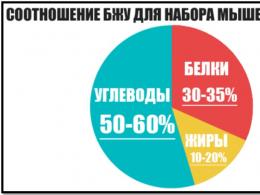Bju for weight loss - calculation of the correct ratio of calories according to the formula
Olya Likhacheva
Beauty is like a precious stone: the simpler it is, the more precious :)
According to the canons of healthy eating, a person must adhere to an individual daily calorie intake in order to maintain a good body quality or lose weight. However, in addition to it, it is important to know the ratio of BJU for weight loss - or proteins, fats and carbohydrates, i.e. key components of each product. How to find out these numbers, how true are the online calculators and what factors change the proportions between these elements?
What is BJU
Each food product has its own calorie content or the amount of energy that can be "pulled" out of it, and is formed from nutrients - substances that provide human life. The "Golden Three" are proteins, fats and carbohydrates, which received the common abbreviation BJU. In the daily diet, the content of all 3 elements is necessary, since each has its own value, but at the same time it is required to observe a certain amount of proteins, fats and carbohydrates per day, which will allow maintaining harmony in the functioning of all systems.
BJU functions
There is no less or more significant nutrient in the mentioned trio - they all have a large list of tasks that they perform, and the functions of the BJU must be considered separately for each element:
- Protein. It is defined by specialists as a “building material” for bone and muscle tissue, occasionally it becomes a source of energy if the body cannot take it from carbohydrates. Protein is not compensated from other elements, so the deficiency of this nutrient is especially difficult to tolerate.
- Carbohydrates. A key element for life, since energy is taken from them by the body. Carbohydrate deficiency is a breakdown, loss of concentration, a constant feeling of hunger. According to their structure, they are divided into simple and complex, according to the number of molecules. The latter provide benefits to the body.
- Fats. When losing weight (especially in strict diet schemes), often a person tries to eliminate any fats, not realizing that this step is detrimental to health. Lipids have a function no less important than that of the other participants in the BJU chain: they regulate cholesterol levels, the activity of the central nervous system, and lipid metabolism.

Norma BJU
A competent proportion between these nutrients is compiled with an eye to their roles in the body. Carbohydrates are mainly responsible for replenishing energy costs, so there should be more than half of the daily plate, otherwise you will begin to experience a constant desire to eat something and lack of strength to move. Muscles need less "material" for their life and growth, so proteins need about 1/3 of the daily diet. Fats are taken minimally, to maintain their balance - this is 10%. The final ratio of BJU with proper nutrition is 30:10:60.
The ratio of BJU for weight loss
On the question of the balance between these nutrients, different nutritionists have their own views. Even the above optimal ratio of proteins, fats and carbohydrates is not the only option (and not only for weight loss): some experts argue that it is more reasonable to have a rough guideline, and not hard numbers. So the norm of proteins is allowed within 10-35% of calories from the entire plate per day, carbohydrates - from 45 to 65%, and fats - from 20% to 35%. Here you can see a shift in the balance towards an increase in lipids, and it is assumed that there are fewer proteins than according to the main BJU formula.
The ratio of BJU for weight loss for women
The shift in proportions is also determined by the gender of the person who decided to lose weight, since the internal processes in men and women, as well as nutrient needs, differ. The BJU norm for women suggests a smaller amount of protein than for the representatives of the stronger half, since they have less muscles (the issue of women with strength training is not affected) - up to 1 g per kg of body weight, and when losing weight, this figure can be reduced to 0 .75 g. The proportion according to BJU is 25:20:45, i.e. the proportion of carbohydrates from the classic is reduced.
BJU norm for men
Representatives of the stronger half have a higher need for protein than women, so the norm of BJU for men, even during the period of weight loss, implies the obligatory maintenance of its level, but carbohydrates also go down. The proportion will already look like 35:15:50, or 30:15:55. The amount of protein itself in grams will be considered already as 1-1.4 g for each kg of weight. For a man who gives himself constant physical activity, but at the same time wants to lose weight, the BJU norm per day may suggest a fluctuation in the direction of increasing fat - 30:20:50.
How to calculate BJU
The proportions given above are only a framework with which you still need to learn how to manage. To compile the menu, you also need to know the parameter of the basic metabolism, from which the calculation of the BJU for weight loss will be based on. You can use any of the existing formulas - the most relevant are 3: Harris-Benedict, Muffin-Jeor, Ketch-McArdal. Step by step, the whole system will be like this:
- Calculate the metabolic rate (you need data on age, height (centimeters are used) and weight).
- Multiply by the energy cost factor (according to activity level).
- Reduce by 10-20% (depending on the desired rate of weight loss). When gaining mass - increase.
- Calculate the main nutrients in grams (not percentages!).

Formula for calculating BJU
It is assumed that by the time you start counting the individual amount of protein-fat-carbohydrates for your diet, you have already determined the basic metabolism on which to eat, assessed the degree of active and passive load, and found out how many calories you can eat per day. The universal BJU formula for weight loss in this case will look like this (X is the ideal daily calorie content, the result is in grams):
- 0.3 * X: 4 - for proteins.
- 0.2 * X: 9 - for fats.
- 0.5 * X: 4 - for carbohydrates.
BJU for weight loss in percent
The universal formula, which was discussed earlier, is an average, because it goes against how much a particular person needs for each nutrient. For example, with a calorie intake for weight loss of 1216 kcal, a girl weighing 50 kg and aged 22 needs 50 g of protein (1 g / kg). However, according to that formula, 91.2 g will already come out, which is an excess. Experts advise considering the percentage of BJU for weight loss individually, given that:
- For 1 kg of actual weight, when losing weight, protein needs 1-1.4 g. At the drying stage - 2-2.5 g.
- Carbohydrates will take half of the calories.
- The rest goes to fats.

BJU calculator for weight loss
The number of formulas will easily confuse a beginner in the matter of nutrition, therefore, for those who independently figure out how to calculate BJU for weight loss correctly, it is difficult, you can resort to online programs and counters. They work in a similar way - they first calculate your basal metabolic rate, multiply by your activity level, then give you your calories per day. Next, a combination of BJU will be calculated, and some services offer a separate free calculator of carbohydrates online or proteins. The disadvantage of these programs is a high error.
Food according to BJU
With the decoding of the abbreviation, there are no questions, how much of each nutrient to consume to speed up metabolism and fat burning is understandable. However, the topic of BJU nutrition is not closed on this, because it is not clear how to make a daily menu. Excess weight will go away if:
- Achieved 150g (dry weight) low GI carbohydrate intake.
- The lipids in food are broken down as - 30% vegetable and 70% animal. Trans fats are excluded.
- Animal proteins predominate (55%) over vegetable proteins (45%).
Video: How to calculate the BJU rate
Attention! The information presented in the article is for informational purposes only. The materials of the article do not call for self-treatment. Only a qualified doctor can make a diagnosis and give recommendations for treatment based on the individual characteristics of a particular patient.
Did you find an error in the text? Select it, press Ctrl + Enter and we'll fix it!





